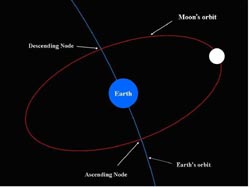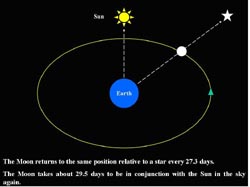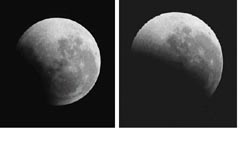Fig (1)
The Moon, our Sister Planet
http://photojournal.jpl.nasa.gov/jpeg/PIA00405.jpg
Courtesy: NASA-JPL
Fig (2)
Man lands on the Moon
http://grcimagenet.grc.nasa.gov/GRCDigitalImages/1995/1995_03456L.jpg
Courtesy: NASA
Our Sister Planet
The Moon is our nearest cosmic neighbor and our faithful companion that follows planet Earth wherever it goes through its cosmic voyage.
The Moon is a cold rocky planet measuring 3,476 km across. The Moon does not shine light of its own; it merely reflects sunlight falling on its surface. Amazingly, the Moon reflects only about 6% of the sunlight that strikes its surface. This reflectivity is close in value to that of coal or blackboard.
Our planet is much larger than the Moon. Earth, with a mass of approximately 6 x 10 24 kg, is over 80 times more massive than the Moon.
The Earth's diameter (about 12,756 km ) is over 3 times larger than that of the Moon. The volumes of the Earth and the Moon are approximately 108.3 x 1010 km 3and 2.2 x 1010 km3 , respectively, i.e., Earth is about 50 times larger in volume than the Moon. (If the Earth were hollow, there would be enough space inside Earth for 50 Moon-sized planets.)
Interestingly, the ratio between the sizes of Earth and the Moon is similar to that between the basketball and the baseball.
Fig (3)
The Earth and the Moon imaged to scale

(This image was made using NASA images of the Earth and the Moon.)
The Moon does not have a substantial atmosphere, and there is no liquid water on its surface. The surface of the Moon is very rugged, featuring lofty mountains, lowlands and countless craters of various sizes and depths. These craters have been caused by meteoritic impacts and some of them are over 200 km across. Fig (4)
A huge crater on the Moon
http://photojournal.jpl.nasa.gov/jpeg/PIA00094.jpg
One of the most amazing new discoveries was evidence for the existence of vast areas of water ice in the polar regions of the Moon. These frozen areas believed to lie deep in lunar craters, hidden from sunlight.
The range of the temperature of the lunar surface is from about -120°C to 120°C .
The Orbit of the Moon
The orbit of the Moon is not exactly circular; it is rather slightly elliptical in shape, with the Earth located at one of the foci of this orbit. So, the Moon's distance from the Earth changes along its orbit from a minimum value of about 363,300 km to nearly 406,000 km .
(The minimum and maximum distances of the Moon from the Earth are termed perigee and apogee, respectively; these terms are of Greek origin.)
Consequently, the apparent size of the Moon changes noticeably from perigee to apogee. The mean apparent diameter of the Moon is approximately 31 minutes of arc. As the sky is spherical in shape (shaped like a dome), the apparent sizes of the celestial objects and the distances on the sky are measured in degrees, minutes of arc and seconds of arc.
The Moon orbits the Earth once every 27.32 days. This period is known as the sidereal period of the Moon as it is measured relative to the stars. That is, in this period, the Moon completes one orbit around the Earth and returns to the same position relative to the stars in the sky. As the stars are so distant from the Earth, their intrinsic motions are negligible when compared to the Moon's orbital motion, and the stars are presumably fixed relative to the Moon.
The Moon rotates synchronously around the Earth, i.e., it keeps the same face toward the Earth as it rotates about its axis once every siderial period. The lunar hemisphere directed away from the Earth is termed the farside of the Moon.
Fig (5)
The farside of the Moon
http://nssdc.gsfc.nasa.gov/imgcat/hires/a16_m_3021.gif
The mean orbital speed of the Moon is 1.02 km/s; it increases slightly to a maximum of 1.08 km/s at perigee and decreases to a minimum of 0.96 km/s at apogee. These speeds are comparable to supersonic jet planes such as the Concorde jetliner. Actually, some airplanes are used to chase the lunar shadow during total solar eclipses to afford a prolonged observing time of totality for observers onboard the plane.
The lunar orbit is tilted at slightly over 5 degrees with respect to the plane of the Earth's orbit around the Sun. (The Earth's orbit around the Sun is termed the ecliptic.) The orbital planes of the Earth and the Moon intersect at two points called the nodes. The two nodes are termed the ascending node and the descending node respectively. Eclipses of the Sun and the Moon occur only if the Moon is near or at a node.
Fig (6-a)
The nodes of the lunar orbit

When the Moon crosses the ascending node, it moves north of the ecliptic. When the Moon crosses the descending node, it moves south of the ecliptic.
Fig (6-b)
The ascending and the descending nodes of the Moon

Fig (7)
The synodic and sidereal periods of the Moon

As the Moon orbits the Earth, it returns to the same position relative to the Sun in the sky about every 29.53 days or 709 hours. This is the synodic period of the Moon, on which the months of lunar calendars (e.g., the Islamic calendar) is based.
Unlike the stars, the Sun appears to move across the sky, and cannot be considered stationary relative to the Moon. This apparent solar motion is due to the orbital motion of the Earth around the Sun. Since the Earth revolves around the Sun, the Sun is actually stationary relative to the Earth, but from our point of view we feel that the Sun orbits the Earth and moves around the sky every year.
This is similar to the apparent motion of trees relative to a passenger in a train.
During the synodic period, the Moon goes through a complete cycle of phases from New Moon through waxing crescent, First Quarter, waxing gibbous, Full Moon, waning gibbous, Last Quarter and waning crescent to New Moon back again.
Fig (8)
The phases of the Moon
http://starchild.gsfc.nasa.gov/Images/StarChild/icons/moon_from_earth.gif The New Moon cannot be seen from the Earth as the nightside of the Moon is directed toward it at New Moon.
At Full Moon we see all the dayside of the Moon. The Full Moon rises at sunset, and is located opposite to the Sun in the sky and sets in the morning around sunrise.
The Eclipses of the Moon
Fig (9)
The geometry of lunar eclipses
http://lunar.arc.nasa.gov/science/images/eclipse.gif
A lunar eclipse happens when the Moon passes in the shadow of the Earth and becomes darkened.
Like a tree, a building or yourself, the Earth casts a shadow due to sunlight. The shadow of the Earth is very large; it extends in space for nearly 1.4 million km. The length of the Earth's shadow varies by about 23,000 km due to the variable distance of the Earth from the Sun. So, the Earth's shadow is long enough to extend beyond the lunar orbit.
In a lunar eclipse, the Earth, Sun and Moon are lined up and the Earth lies between the two objects. Viewing this alignment from above or from the side shows that the three objects lie on one line.
A total lunar eclipse happens only when the Moon is Full, but we do not observe a lunar eclipse every month due to the inclination of the lunar orbit with respect to the ecliptic. At Full Moon the Moon usually passes above or below the orbital plane of the Earth along which the Earth's shadow is cast.
The Earth's shadow consists of two overlapping parts that are conical in shape. In the outer part, the penumbra, the Earth blocks only part of the light coming from the Sun. The inner, darker part is known as the umbra, and it is opaque to all light coming directly from the Sun to the Moon.
The umbra has a diameter of about 10,000 km or 2.8 times the lunar diameter at the lunar orbit.
Ancient Greek astronomers argued that the Earth is spherical (not flat) when they found that the Earth's shadow cast on the Moon during lunar eclipses is circular in shape.
Types of Lunar Eclipses
There are three types of lunar eclipses: penumbral lunar eclipses, partial lunar eclipses and total lunar eclipses. The type of lunar eclipse is determined by the path of the Moon through the Earth's shadow.
Penumbral Lunar Eclipses
Animation:
The passage of the Moon through the Earth's penumbra
http://science.nasa.gov/headlines/y2005/images/lunareclipse/Penumbra_new.gif
A penumbral lunar eclipse occurs when the Moon passes through the Earth's penumbral shadow. Also, both partial and total lunar eclipses are preceded by a penumbral lunar eclipse. This type of lunar eclipse is very difficult to perceive with the unaided eye as the penumbra of the Earth is very faint and the Moon is only darkened slightly.
Powerful amateur telescopes can show a pale shading sweeping across the lunar disk during penumbral lunar eclipses.
Partial Lunar Eclipses
In a partial lunar eclipse, only a part of the Moon's disc passes through the Earth's umbral shadow. A partial lunar eclipse is less beautiful than a total lunar eclipse but it is a wonderful telescopic sight.
Fig (10)
Images of the partial phase of the total lunar eclipse of 4 May 2004

Photo by Aymen Ibrahem, PSC, senior astronomy specialist Total Lunar Eclipses
Animation:
The total lunar eclipse of 4 May 2004
http://antwrp.gsfc.nasa.gov/apod/image/0311/112003lunareclipse_koehn.gif
A total lunar eclipse occurs when the Moon is entirely immersed in the Earth's umbral shadow. The totality phase may be up to one hour and 40 minutes long and the entire eclipse may last up to 3 hours.
The Moon is not completely dark during totality because some sunlight can still reach the surface of the Moon as it gets deflected by the Earth's atmosphere. In this case our atmosphere acts as a huge natural lens that refracts Sunrays passing through. If the Earth had no atmosphere, then the Moon will disappear during totality as any direct rays from the Sun will be blocked by the Earth's umbra.
The total lunar eclipses are among the most beautiful natural phenomena. Around and through totality, the Moon glows in various hues of red, orange and yellow, as the sunlight reaching the Moon gets filtered in Earth's atmosphere. Our atmosphere filters the shorter blue and green wavelengths of the light coming from the Sun and allows the longer red wavelengths to reach the Moon.
The colors the Moon takes on through totality vary according to the transparency of Earth's atmosphere. The presence of dust and clouds in the atmosphere makes these colors tend to be dark.
Total lunar eclipses become less vividly colored after major volcanic eruptions as these catastrophic events eject large amounts of volcanic ash into the atmosphere. For instance, during the total lunar eclipse of 9 December 1992, the Moon appeared rather brown due to the ash ejected by Pinatubo Volcano.
A total lunar eclipse is certainly less spectacular than a total solar eclipse, but it has some advantages over its solar counter part:
- The shadow of the Earth is much larger than that of the Moon and totality in a total lunar eclipse may last over one hour and 40 minutes. This permits observers to enjoy viewing and photographing this marvelous sight for a long period.
- A total lunar eclipse is visible from the entire night hemisphere of the Earth (the hemisphere that faces the Moon during the eclipse) but the total solar eclipse is visible only along the thin totality path. Thus, the total lunar eclipses can be viewed several times in the lifetime of a single observer.
- All lunar eclipses are easy and quite safe to observe with the unaided, unprotected eye. You do not need any filters or special instruments to view a lunar eclipse. A total lunar eclipse is a beautiful phenomenon to behold, and with a small telescope or even a binocular, the view of a totally or partially eclipsed Moon is even more spectacular.
Coming Lunar Eclipses
Every year, there are at least two lunar eclipses of any type, and commonly a total lunar eclipse occurs every two years. The partial lunar eclipses are slightly more frequent than the total ones. The year 1982 witnessed three total lunar eclipses, and this was the third time in the twentieth century to have three lunar eclipses in one year.
The last total lunar eclipse that was visible in Egypt was on 28 October 2004. The next total lunar eclipse visible in Egypt will be on 3 March 2007. It will also be visible in Africa, Europe, Asia and Australia . A partial lunar eclipse will be visible in Egypt on 6 September 2006. This eclipse will be relatively short, lasting only 92 minutes, as the Moon will only graze the limb of Earth's umbral shadow.
Astronomer Aymen Ibrahem of the PSC photographed several total lunar eclipses and his photos of 4 May 2004 total lunar eclipse appeared in the Lunar Eclipse Gallery of NASA's Spaceweather.com and the Venus Transit 2004 Photo Gallery of the European Southern Observatory.
Further Reading
A Solar Eclipse on the Moon
http://science.nasa.gov/headlines/y2005/20apr_lunareclipse.htm
Total Lunar Eclipse
http://science.nasa.gov/headlines/y2004/13oct_lunareclipse.htm
Aymen Mohamed Ibrahem
PSC, senior astronomy specialist |

